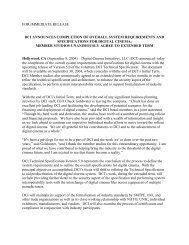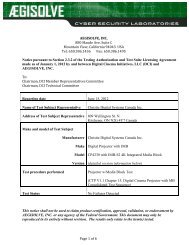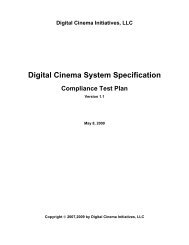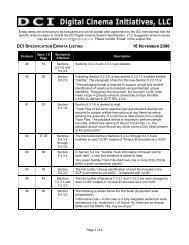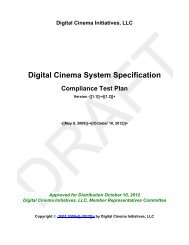DCI Specs - Digital Cinema Initiatives
DCI Specs - Digital Cinema Initiatives
DCI Specs - Digital Cinema Initiatives
You also want an ePaper? Increase the reach of your titles
YUMPU automatically turns print PDFs into web optimized ePapers that Google loves.
9.1. Introduction9. SECURITYThis section defines the requirements for <strong>Digital</strong> <strong>Cinema</strong> security. Though security is an end-toendprocess, these specifications are focused on the exhibition environment. The high levelbusiness requirements for security are:• Enable the decryption and playback of feature films, based upon business rules agreedupon by Exhibition and Distribution.• Provide persistent security protection against unauthorized access, copying, editing, orplayback of feature films.• Provide records of security-related events.The high level technical requirements for security are:• Meet the above business requirements.• Define an open security architecture.• Provide a minimum set of standards around which the exhibition security infrastructurecan be implemented by multiple equipment suppliers.Security is provided primarily through the application of encryption technology and themanagement of content key access. When content is transported and received in an encryptedfashion, it is necessary to establish standardized methods of delivering and utilizing decryptionkeys to unlock the content. This is known as key management. Associated with key exchange isDRM (<strong>Digital</strong> Rights Management), which establishes the rules for using content. Themanagement of DRM is known as security management. DRM requirements include logging ofcontent access and other security event information.In the security architecture defined herein, security management functions are entrusted to aSecurity Manager (SM), a logically separable and functionally unique component of thearchitecture. The security system is referred to as the infrastructure that provides securityfeatures, and the Security Manager is at the heart of this infrastructure. At exhibition, each<strong>Digital</strong> <strong>Cinema</strong> auditorium shall have its own dedicated security system, which is comprised ofmultiple subsystems under the supervision of the Security Manager. The security systemarchitecture is defined to provide open and standardized security operation and enableinteroperability between an exhibition SM and the rest of the exhibition security infrastructure.Section 9 SECURITY is organized as follows:• Fundamental Security Requirements (Section 9.2)– System-level goals, whichsecurity implementations are required to meet.• Security Architecture Overview (Section 9.3)– Definitions and description of the basicsecurity architecture, security messaging, and role of the Security Manager.• Theater Systems Security (Section 9.4)– Security and equipment functions, behaviorrequirements and security operations at exhibition.• Implementation Requirements (Section 9.5)– Requirements for equipmentimplementation, physical and logical robustness and certification.• Security Features and Trust Management (Section 9.6) – The requirements andimplementation of security policy and trust infrastructures.<strong>DCI</strong> <strong>Digital</strong> <strong>Cinema</strong> System Specification v.1.2 Page 91




